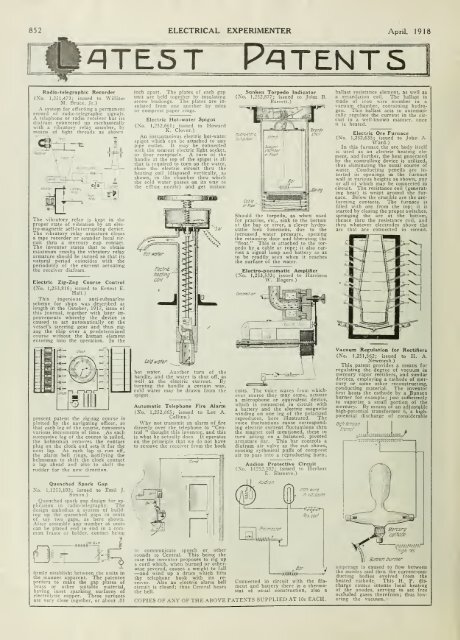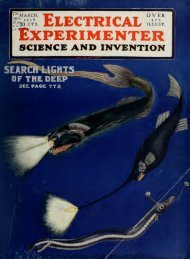The Electrical experimenter
The Electrical experimenter
The Electrical experimenter
You also want an ePaper? Increase the reach of your titles
YUMPU automatically turns print PDFs into web optimized ePapers that Google loves.
852 ELECTRICAL EXPERIMENTER April, 1918<br />
^TE5T PATENTS<br />
Radio- tele graphic Recorder<br />
( Xo. 1,251,473; issued to William<br />
M. Bruce, Jr.)<br />
A system for effecting a permanent<br />
record of radio-telegraphic signals.<br />
A telephone or radio receiver has its<br />
diafram connected up mechanically<br />
with a vibratory relay member, by<br />
means of light threads as shown<br />
<strong>The</strong> vibratory relay is kept in the<br />
proper state of vibration by an electro-magnetic<br />
self-interrupting device.<br />
<strong>The</strong> vibratory relay armature closes<br />
a tape recorder or sounder local circuit<br />
thru a mercury cup contact.<br />
<strong>The</strong> inventor states that to obtain<br />
maximum results the vibratory relay<br />
armature should be turned so that its<br />
natural period coincides with the<br />
periodicity of the current actuating<br />
the receiver diafram.<br />
Electric Zig-Zag Course Control<br />
(Xo. 1,253,816; issued to Ernest E.<br />
Hall.)<br />
This ingenious anti-submarine<br />
scheme for ships was described at<br />
length in the October, 1917, issue of<br />
this journal, together with later improvements<br />
whereby the device is<br />
caused to act automatically on the<br />
vessel's steering gear and thus zigzag<br />
the ship over a predetermined<br />
course without the human element<br />
entering into the operation. In the<br />
present patent the zig-zag course is<br />
plotted by the navigating officer, so<br />
that each leg of the course, consumes<br />
various increments of time. As each<br />
successive leg of the course is sailed,<br />
the helmsman removes the contact<br />
plug on the clock and sets it for the<br />
next lap. As each lap is run off,<br />
the alarm bell rings, notifying the<br />
helmsman to shift the clock contact<br />
a lap ahead and also to shift the<br />
rudder for the new direction.<br />
Quenched Spark Gap<br />
Xo. 1,1253,103; issued to Emil J.<br />
Simon.)<br />
Quenched spark gap design for application<br />
in radio -telegraphy. <strong>The</strong><br />
design embodies a system of building<br />
up the quenched gaps in units<br />
of say two gaps, as here shown.<br />
After assembly any number of units<br />
can be placed end to end in a common<br />
frame or holder, contact being<br />
firmly establisht between the units in<br />
the manner apparent. <strong>The</strong> patentee<br />
prefers to make the gap plates of<br />
brass or other suitable material,<br />
having inset sparking surfaces of<br />
electrolytic copper. <strong>The</strong>se surfaces<br />
are very close together, or about .01<br />
.<br />
inch apart. <strong>The</strong> plates of each gap<br />
unit are held together by insulating<br />
screw bushings. <strong>The</strong> plates are insulated<br />
from one another by mica<br />
or comprest paper rings.<br />
Electric Hot-water Spigot<br />
(No. 1,252,661; issued to Howard<br />
K. Clover.)<br />
An instantanious electric hot-water<br />
spigot which can be attached to any<br />
pipe outlet. It may be connected<br />
with the nearest electric light socket,<br />
or floor receptacle. A turn of the<br />
handle at the top of the spigot is all<br />
that is required to turn on the water,<br />
close the electric circuit thru the<br />
heating coil (disposed vertically, as<br />
shown, in the chamber thru which<br />
the cold water passes on its way to<br />
the efflux nozzle) and get instant<br />
Cold wafer<br />
hot water. Another turn of the<br />
handle, and the water is shut off, as<br />
well as the electric current. By<br />
turning the handle a certain way,<br />
cold water may be drawn from the<br />
spigot.<br />
Automatic Telephone Fire Alarm<br />
(Xo. 1,252,665 ; issued to Lee A.<br />
Collins.)<br />
Why not transmit an alarm of fire<br />
directly over the telephone to "Central<br />
" thought this inventor, and this<br />
is what he actually does. It operates<br />
on the principle that we do not have<br />
to remove the receiver from the hook<br />
-1<br />
to communicate speech or other<br />
sounds to Central. This being the<br />
case the inventor proposes to rig up<br />
a cord which, when burned or otherwise<br />
severed, causes a weight to fall<br />
—and wind up a drum which lifts<br />
the telephone hook with its receiver.<br />
Also an electric alarm bell<br />
circuit is closed; thus Central hears<br />
the bell.<br />
Sunken Torpedo Indicator<br />
(Xo. 1,252,877; issued to John B.<br />
Barrett.)<br />
Cable<br />
orPope<br />
Jprmg<br />
I<br />
Should the torpedo, as when used<br />
for practise, etc., sink to the bottom<br />
of the bay or river, a clever hydrostatic<br />
lock functions, due to the<br />
increased water pressure, opening<br />
the retaining door and liberating the<br />
'"float." This is attached to the torpedo<br />
by a cable or rope; it also carries<br />
a signal lamp ana battery so as<br />
to be readily seen when it reaches<br />
the surface of the water.<br />
Electro-pneumatic Amplifier<br />
(Xo. 1,253,533; issued to Harrison<br />
W. Rogers.)<br />
Qnpmroir<br />
cuits. <strong>The</strong> voice waves from whichever<br />
source they may come, actuate<br />
a microphone or equivalent device,<br />
which is connected in circuit with<br />
a battery and the electric magnetic<br />
winding on one leg of the polarized<br />
reproducer, here illustrated. <strong>The</strong><br />
voice fluctuations cause corresponding<br />
electric current fluctuations thru<br />
the magnet coil mentioned, these in<br />
turn acting on a balanced, pivoted<br />
armature bar. This bar controls a<br />
diafram air valve as the cut shows,<br />
causing rythmical puffs of comprest<br />
air to pass into a reproducing horn;<br />
Audion Protective Circuit<br />
(Xo. 1(252.502: issued to Herbert<br />
E. Shreeve.)<br />
4ud/on<br />
ftermjsfot<br />
-HUM! -<br />
/ran mre<br />
iff vacuum<br />
/fes co//<br />
Connected in circuit with the filament<br />
and battery there is a thermostat<br />
of usual construction, also a<br />
COPIES OF ANY OF THE ABOVE PATENTS SUPPLIED AT 10c EACH.<br />
f<br />
ballast resistance element, as well as<br />
a retardation coil. <strong>The</strong> ballast is<br />
made of iron wire member in a<br />
vacuum chamber, containing hydrogen.<br />
This ballast acts to automatically<br />
regulate the current in the circuit<br />
in a well-known manner, once<br />
it is heated.<br />
Electric Ore Furnace<br />
(Xo. 1,252,635; issued to John A.<br />
Ward.)<br />
In this furnace the ore body itself<br />
is used as an electric heating element,<br />
and further, the heat generated<br />
by the controlling device is utilized,<br />
thus eliminating the usual source of<br />
waste. Conducting pencils are inserted<br />
in openings in the furnace<br />
wall at various heights as shown, any<br />
or all of which may be connected in<br />
circuit. <strong>The</strong> resistance coil (generating<br />
heat) is wrapt around the furnace.<br />
Below the crucible are the arcforming<br />
contacts. <strong>The</strong> furnace is<br />
filled with ore from the top; it is<br />
started by closing the proper switches,<br />
springing the arc at the bottom,<br />
thence thru the resistance coil, and<br />
thru whatever electrodes above the<br />
arc that are connected in circuit.<br />
Vacuum Regulation for Rectifiers<br />
(No. 1,251,562; issued to H. A.<br />
Newcomb.)<br />
This patent provides a means for<br />
regulating the degree of vacuum in<br />
mercury vapor rectifiers, and similar<br />
devices, employing a cathode of mercury<br />
or some other reconstructing,<br />
conducting material. <strong>The</strong> inventor<br />
first heats the cathode by a Bunsen<br />
burner for example; just sufficiently<br />
to vaporize a small portion of the<br />
mercury. By means of an adjustable<br />
high-potential transformer 6, a highpotential<br />
discharge of considerable<br />
tltgh tension<br />
trans<br />
Bunsen Oarner<br />
\tigh r ss<br />
amperage is caused to flow between<br />
the anodes and thru the current-conducting<br />
bodies evolved from the<br />
heated cathode. This H. P. discharge<br />
causes intense local heating<br />
of the anodes, serving to set free<br />
occluded gases therefrom; thus lowering<br />
the vacuum.




